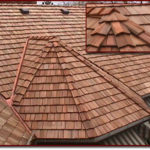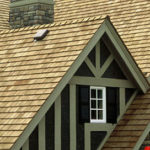WHAT MAKES CEDAR SHAKE ROOFING THE BEST CHOICE TODAY?
Cedar wood is still, to this day, a major construction material for building homes, small businesses, and various types of furniture in the Chicago area. Because of the incredibly long history of using cedar wood for building and crafting material, spanning over thousands of years, it is highly unlikely that this will ever change.
Resistant To Rot and Decay With Cedar Shake Maintenance
Cedar is naturally resistant to rot and ultimate decay due to excessive exposure to rain, is abhorrent to many types of insects such as moths and subterranean termites, will not fade or corrode because of natural element exposure, and have very little tendency to shrink and bow.
This pleasant smelling material naturally enhances what it is being used to build, adding beauty, character, and unusual longevity compared to other types of wooden structures.
Long Lasting Quality of Cedar Roofing
To give you a greater idea as to the lasting quality of cedar wood, churches in Norway and similar types of buildings in Japan were constructed using cedar and have lasted for over a thousand years.
The native peoples of western Canada’s British Columbia are recorded to have removed huge slabs of the outer bark of cedar trees to hand-split and use as roofing material. This practice has been passed down from generation to generation, purportedly for thousands years, simply because these people knew a good thing when they saw it.
Cedar Shingle Vs. Cedar Shake
You may have heard the terms “shingle” and “shake” used interspersed among themselves in various instances. This is not uncommon for a lay person, or one who doesn’t quite know the jargon of the Chicagoland area construction industry. For this reason, it is appropriate to set the confusion straight by informing you about the difference between a “shake” and a “shingle.”
Cedar shakes of any common type, used by area Cedar Shake Roofers, are usually split by a hand tool or other type of mechanism. They are thicker in depth, enhancing the texture of the piece of wood, while also leaving a more rustic or natural look to what the shake is being used for.
Cedar shingles is a term more commonly used for all types of roofing materials, whatever they may be made from. As opposed to the rustic charm of shakes, shingles appear as more uniform in shape. They are thinner than shakes and are cut, not split. This produces a crispness and more modern look. Whatever your final choice happens to be, both cedar shakes and shingles are continuously high in performance and are very practical in their use as a Chicago area roof covering.
Structural Performance Is A Great Reason to Switch to Cedar Roofing!
Cedar roofing shakes and shingle siding are the most imitated building materials in the construction product industry. The look of cedar automatically enhances the value to the house or building of business that it is used on, adding much charm and certain elegance to the structure.
Quality cedar shakes or shingles, when installed properly and with special attention, can last 30 plus years, sometimes up to 50. When referencing a structure’s roof integrity, having cedar shake roofers install real cedar shakes as the roofing material instantly improves performance, giving sound proof of the material being up to measure.
Where Do Cedar Shakes Come From?
Though, the North American Western Red Cedar is called such, this species of coniferous tree is actually included in the cypress family of Cupressaceae.
This being said, the Western Red Cedar is widely used for outdoor construction projects, including shingle production. The Western Red is popularly known to be decay-resistant due to its high content of tannic acid. The tannic acid is what gives this “cedar” tree its wonderful and prized aroma.
Another species that is a popular tree for making siding and roofing shingles is the Northern White Cedar of the Northeastern Canadian/American region. Because of the Northern White’s smaller stature, it is primarily used for smaller projects and for producing commercial and residential shingles, but due to the tree’s much lower tannic acid levels, is not known to last as long as other cedar species when used in construction projects. The Northern White Cedar is also the lightest in density of all the commercial woods.
Cedar Roof Preservation In Chicago IL – Essential To A Long Lasting Cedar Roof
Roofing materials made from cedar wood are both self-sustainable as well as environmentally friendly, requiring virtually no maintenance and much less energy to produce by factory. Cedar woods remove greenhouse gases which are emitted into the atmosphere every day, damaging the earth’s precious ozone layer.
Synthetic, man-made materials produced using twice as much energy, thus causing tons of greenhouse gas emissions to escape into the air, while the water and soil quality around their factories are significantly lessened. On the other hand, cedar material production has the lowest impact on air and water quality near their factories.
Yes, cedar construction material production is definitely safer for the environment itself, but cedar wood, alone, significantly minimizes external and internal pollutants by purification through its natural filtration process. For these reasons, cedar wood is environmentally safe and structurally secure for use in Chicagoland home and commercial roofing projects.
THE CHOICE OF ROOFING MATERIAL SHOULD BE CLEAR
North American forests have grown 20 percent since recorded last in 1970. This is due to the lumber producers’ exceptional diligence and attention in replacing the harvested trees.
Cedar trees are among these forests, being continuously replenished after cut and harvested for production. What is special about these trees is that the roofing materials can be recycled and regenerated to show, once again, their lustrous under layer. They are also biodegradable if thrown out, per chance.
Because cedar shakes are pitch and resin free, they are more than safe to handle and are, once again, great for the environment. The surface of cedar wood is well known to work very well with holding all types of finishes, including stains, bleaches, and paints.
Learn more about the Responsible Sustainability of cedar forests and other benefits of cedar.
If fire prevention is your concern, whether you must adhere to a community housing code or not, cedar shakes and shingles, as well as planks, can be fire treated using a specific spray product. Another added benefit is that cedar products can be pressure treated to prevent growth of moss or fungi, according to what type of environmental region you may live.
As you well know, the Chicago area can get a multitude of different weather elements. Thankfully, cedar shakes and shingles are resistant to the damaging effects of hail and can withstand winds up to 130 miles per hour. These natural roofing materials also do wonders for those wishing to save on their energy bill.
Cedar wood produces naturally occurring thermal enhancers, saving the home or business owner a significant amount of money which would be otherwise used towards unnecessary heating and cooling costs.
The choice, of course, is yours as to whether or not you will want to use this information to make an entirely educated decision for your next building project. The switch to cedar roofing is more often than not a financial decision.
The cost upfront is determined upon the amount of area that is to be covered and the type of installation that is chosen.
Researching cedar shake roofers residing or serving inside your local Chicago area should be your next step in deciding for yourself what type of look and roof integrity you are after and deserve.
American Roof Preservers is an expert with 40 years of experience maintaining, preserving and restoring cedar roofs.
Call us today 888-585-5502, to schedule a free inspection to make sure your cedar roof is well maintained and healthy.




